In dentistry, precision is not just a goal—it's a necessity. The success of various dental procedures, from cavity preparations to crown placements, hinges on the ability to cut tooth structure and restorative materials efficiently and accurately. One of the most critical tools in a dentist's arsenal is the dental bur, particularly those with diamond grit. However, the performance of these burs is significantly influenced by three key factors: the diamond grit size, the speed of the handpiece, and the pressure applied during use. Understanding how these variables interact can drastically improve the quality of your work and the comfort of your patients.
Understanding Diamond Grit
The Role of Grit Size in Dental Burs
Diamond grit refers to the size of the diamond particles embedded in the bur, which plays a crucial role in determining its cutting efficiency and the finish of the prepared surface. The grit size is typically categorized as coarse, medium, fine, or extra-fine.
- Coarse Grit: Coarse-grit burs are designed for rapid material removal. They are ideal when you need to quickly reduce tooth structure or remove old restorations. However, the trade-off is a rougher surface finish, which may require further smoothing with finer burs.
- Fine and Extra-Fine Grit: These burs are used when a smooth, polished finish is needed, such as in the final stages of preparing a tooth for a crown. They remove less material per pass, but the result is a much finer, more precise finish.
In practice, the choice of grit size can have a significant impact. For instance, when working on a large amalgam removal case using a medium grit bur would balance efficiency and finish. However, medium grit bur will left the surface rough for immediate restoration placement. Switching to a fine grit bur made all the difference, allowing for a smoother surface that was ready for the next step without additional adjustments. This does not applied to adding in other related variables.
The Role of Speed in Dental Burs
Rotational Speed: Low vs. High
The speed at which a dental bur rotates is another critical factor that affects cutting efficiency and the outcome of the procedure. Dental burs can operate at low or high speeds, depending on the handpiece used.
- High-Speed Burs: Operating at speeds up to 400,000 RPM, high-speed burs are perfect for rapid cutting and shaping. They are especially useful in procedures requiring significant material removal, such as crown preparations or sectioning teeth. However, the high speed generates considerable heat, which can potentially damage the tooth's pulp if not adequately managed with water or air cooling.
- Low-Speed Burs: These typically operate at speeds under 40,000 RPM and are used for procedures requiring greater control, such as caries removal near the pulp. While they offer more precision, the slower speed means the cutting process is less efficient, potentially leading to longer procedure times.
The Influence of Pressure on Cutting Results
Optimal Pressure: Finding the Balance
The pressure applied to the bur during use is the third factor that significantly influences the outcome of a dental procedure. Too much pressure can lead to bur deflection, increased wear, and even unintended damage to the tooth structure. Conversely, too little pressure results in inefficient cutting and may cause the operator to overcompensate, leading to fatigue.
- High Pressure: While it can increase cutting speed, excessive pressure can also cause the bur to skip or bounce, leading to an uneven surface and increased heat generation. It also accelerates the wear on the bur, reducing its lifespan
- Low Pressure: Applying lighter pressure allows for more precise control, especially in delicate areas near the pulp or margins of a restoration. However, it requires more time and careful attention to achieve the desired results.
Balancing Pressure with Grit and Speed
The key to achieving optimal results lies in balancing the pressure with the appropriate grit and speed. For example:
- High Grit + High Speed + Moderate Pressure: Ideal for initial tooth reduction but requires careful management to avoid overheating and rough finishes.
- Fine Grit + Low Speed + Light Pressure: Best suited for finishing and polishing, providing a smooth surface with minimal risk of damage.
Practical Tips for Optimizing Cutting Performance
Choosing the Right Bur
Selecting the appropriate bur for the specific clinical task is the first step towards optimizing cutting performance. Understanding the material you're working with—whether enamel, dentin, or a restorative material like composite or ceramic—will guide your choice of grit size, speed, and pressure.
Maintaining Bur Efficiency
Regularly inspecting your burs for wear and replacing them as needed is crucial for maintaining cutting efficiency. Dull or damaged burs not only reduce cutting performance but also increase the risk of damaging the tooth structure.
Training and Skill Development
Continuous education and hands-on practice are vital for improving your ability to manage grit, speed, and pressure effectively. Attending workshops, participating in simulation training, and staying updated with the latest research can greatly enhance your clinical outcomes.
In summary, understanding how diamond grit, speed, and pressure interact is essential for achieving optimal results in dental procedures. By mastering these variables, dental professionals can significantly improve the efficiency and precision of their work, leading to better patient outcomes and a more efficient practice. Whether you're performing a routine cavity preparation or a complex crown placement, the right combination of grit, speed, and pressure can make all the difference.
MR. BUR US provides a wide range of dental burs globally.
Diamond Burs, Carbide Burs, Surgical & Lab Use Burs, Endodontic burs, IPR Kit, Crown Cutting Kit, Gingivectomy Kit, Root Planning Kit, Composite Polishers, High Speed Burs, Low Speed Burs
Subscribe our newsletter now!








